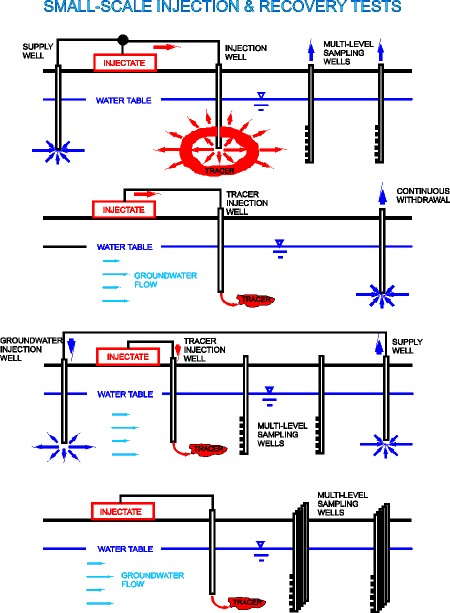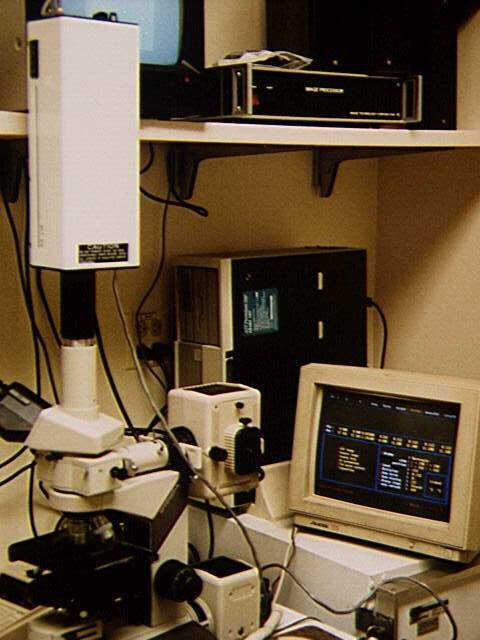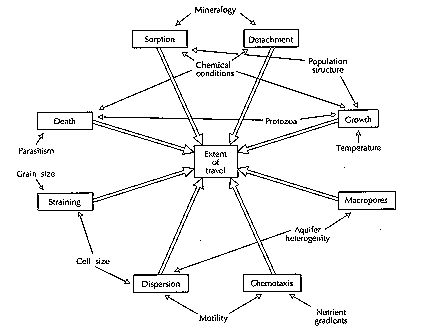

Why is groundwater so important? Over the last 10 years, incidence of water-borne illnesses attributed to groundwater has increased by 50%, which is more than 7 million reported illnesses per year. Also, groundwater can be difficult and expensive to clean up. A quart of oil can contaminate about 500 thousand gallons of groundwater. Viruses, bacteria, and protozoa are differently-sized, have different survival mechanisms, and have different transport characteristics. For these reasons, study of subsurface microbial transport, protection of groundwater resources, and assessments of pathogen risk are complex and often multidisciplinary.
These figures represent how we do field work to look
at the interactions of microbes and contaminants.
We perform injection and recovery experiments (figure at left) to assess
how microbes move in the subsurface. The figure on the left is an illustration
of the types of experiments done in the field. A Forced Gradient
test is where we try to simulate what happens when water is withdrawn
or recharged to an aquifer at high rates and how this affects microbial
movement. A Natural Gradient test is where we want to see
what would happen if there are no influences upon flow. In each case, some
materials (microbes or chemicals known as tracers) are added to a volume
of water which is introduced to the groundwater. This tracer is then monitored
as it passes or moves to a sampling spot. We can then assess how and what
conditions are necessary for different degrees of microbial transport.
In all cases, the microbes that are introduced to the ground are harmless.
Nevertheless, they do often contain analogous characteristics specific
to pathogens. Finally, this type of work requires close collaboration
and consultation with groundwater geohydrologists/modelers, geochemists,
and biologists.
We take samples and look at them with the microscope (figure at right).
Click on the microscope to get an idea of what we
see.
The yellow fluorescing things are bacteria which have been stained
with a dye to make them glow when ultraviolet light is focused on them.
 |
 |
.
Factors Affecting Microbial Movement in the Subsurface
 We all need clean water. Groundwater is a vulnerable resource and
should be protected. Sometimes microbial pathogens (disease causing bacteria,
viruses, or protozoa) can get into water supplies because they can move
or are moved through aquifers. There are many factors which contribute
to the movement of microbes through the subsurface. This diagram illustrates
some of the major factors. Through coupled laboratory and field experiments,
we can estimate the magnitude of each of these effects, the extent to which
they contribute to microbial transport and whether pathogens are being
mobilized in particular aquifer materials. Organzations which use
our data are the EPA, state & local governments, and environmental
consultants. They can then make recommendations to water agencies as to
where water supply wells should be placed so that water supplies won't
be impacted by municipal sewage plants and industrial facilities.
We all need clean water. Groundwater is a vulnerable resource and
should be protected. Sometimes microbial pathogens (disease causing bacteria,
viruses, or protozoa) can get into water supplies because they can move
or are moved through aquifers. There are many factors which contribute
to the movement of microbes through the subsurface. This diagram illustrates
some of the major factors. Through coupled laboratory and field experiments,
we can estimate the magnitude of each of these effects, the extent to which
they contribute to microbial transport and whether pathogens are being
mobilized in particular aquifer materials. Organzations which use
our data are the EPA, state & local governments, and environmental
consultants. They can then make recommendations to water agencies as to
where water supply wells should be placed so that water supplies won't
be impacted by municipal sewage plants and industrial facilities.